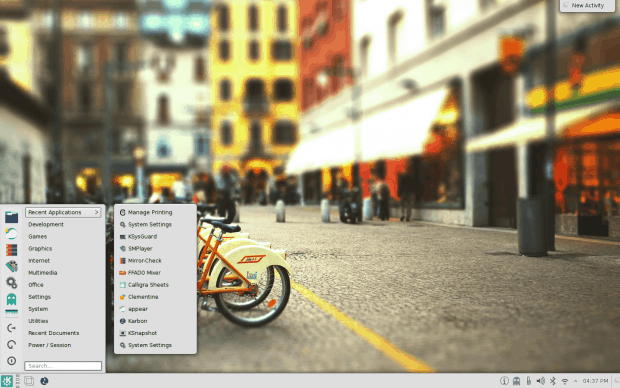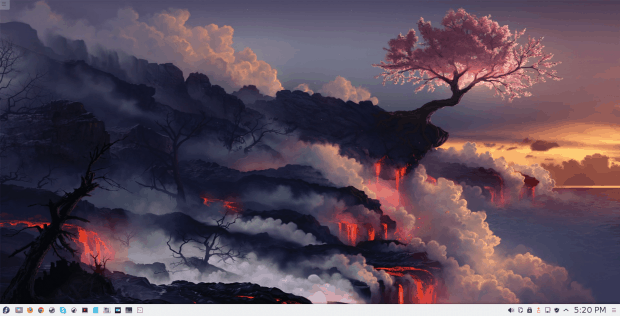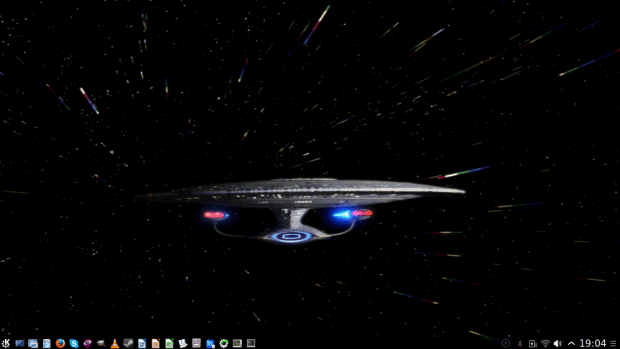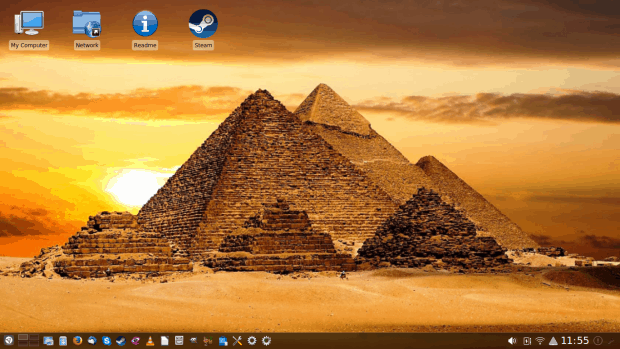The end of the year best-distro nomination is approaching fast. But before that, let’s narrow it down a bit and focus on what KDE and Plasma had to offer the Linux user in 2015. Undoubtedly, it was a very tough year, with some really awesome distributions released in the spring, some rather awful editions coming out earlier this autumn, the birth of Plasma and its attempt to win my heart.
Last year, the winner was openSUSE 13.2, coming back strong after many years of lukewarm performance. Alas, the brief spell of hope was again broken by the Leap release, so it will not come as any surprise to you that you won’t be seeing it in the short list today. But enough spoilers. Let’s focus on what KDE and Plasma – we shan’t discriminate – did for us. What have the Romans ever done for us? That kind of thing.
Candidate 1: KaOS 2014.12
Well, technically, it is a 2014 release, but it went through the Dedoimedo forges only in January, therefore it qualifies. One of those weird distros based on and inspired by Arch, Manjaro, Netrunner, and blood, it comes with a very beautiful presentation layer, which was way ahead of its time, a colorful set of tools and features, and enough entertainment to keep you from getting bored. It was less robust and refined on the installation front, support for various peripherals, and package management. Chaotic, one might say. But still, good enough to feature on this be list.
Candidate 2: Fedora 22
Well, I am being generous, because initially, Fedora didn’t play ball, and it sort of decided to die on my after some rigorous codec escapades. But later on, it delivered a very decent, slick Plasma session, and it is a pretty decent, modern distribution that has a lot of great technologies buried beneath its fickle, artistic surface, so to speak. With a better crop, frankly, it probably would not make it into the short list, but 2015 was a tough year, distrowise, and so we have some less than ideal candidates. Nevertheless, not one to ignore, to be sure.
Candidate 3: Netrunner 15 Prometheus
This was one of the first Plasma releases to come out, featuring its own unique, customized theme that resembles KDE4. A bold pioneer, if you will, and indeed, the delivery wasn’t perfect, with some rough edges and spots. Befitting an early edition of a brand new desktop environment, Prometheus was prone to crashes and heavy memory utilization, offset by beauty, style, tons of ready-to-use software, and a good media stack. In a way, it was a harbinger of things to come.
Candidate 4: Netrunner 16 Ozymandias
Wait, what? Two Netrunner releases? Are you not being biased, Dedoimedo? Well, probably not, given the fact the recent rolling release scored a perfect zero in my testing. To wit, Ozymandias builds on what Promethus created, polishing, fixing improving. Great Plasma experience, lots of applications, a seamless multimedia stack, with problems remaining in the package management space, as well as with peripheral device connectivity and printing. Not the best, but improving. Of course, you may also wonder what Horizon will do, especially since both Kubuntu Werewolf also scored zero. Oh the suspense, stay tuned.
And The Winner is …
Yes, just four candidates, I’m afraid. I had to completely disqualify a lot of distributions, simply because they either refused to run or install, or they delivered a completely abysmal experience that there’s no sane way they could have ended included in any sort of article with the word best in the title.
It was a very difficult year for Plasma, but I guess all transition periods will be. Just look at the mayhem surrounding KDE4, when it came about to displace KDE3.5 from its throne, and how many years and iterations it took before the new version of the desktop was good enough, or stable enough, for production use. Gnome 2, Gnome 3, same thing. In a way, we are bound to repeat the mistakes of history, which is kind of a shame, as Plasma has all the right ingredients to be absolutely the finest desktop environment around, not just within the Linux sphere, but comparing to other operating systems, too. Alas, that means the end-of-the-year vote with just four candidates, none of them a perfect match, or one that ignites the fanboy flames in your heart. So which one is it?
Netrunner 16 Ozymandias – that’s our winner. Again, it is not the best distribution you will ever have used, but in 2015, barring our pending Horizon experiment, it delivered the most optimal Plasma experience, with a solid balance between aesthetics, functionality, stability, and performance. Some big bugs and problems, too, but none as cardinal, critical, big, or repetitive as the rest of the competition. But even so, on its own merit, Netrunner 16 is a reasonable distribution, and you might as well consider giving it a quick spin, if you haven’t done so already.
Conclusion
With slight to moderate reservations and an un-wholehearted embrace of the results, I give you this summary, torn between compromise, cognitive dissonance and genuine heartburn for the state of Linux in general, and Plasma in particular. Tough year, as I’ve mentioned, but there’s some hope in the offing. Plasma may have suffered some big blows recently, but it seems like a temporary squall. We shall weather it out.
If anything, the one distro that seems to have breezed through the storm relatively unscathed seems to be the Ubuntu-based Netrunner family. Worth checking, and may this be a cliffhanger intro to what we’re going to do with Horizon. Everything depends on it. As always, feel free to vent your frustration using the comments function.
Soon, we shall vote on the best Xfce release.
See ya.
Cover Image: Trophy by PublicDomainPictures for Pixabay.com
[sharedaddy]







Why weren’t you happy with the new Opensuse Leap? I though it was quite a good release.
Why? Well, if you check my review, it tells exactly why.
Lots of problems with peripheral devices support, codecs, etc.
Dedoimedo
I tried Horizon, lasted a week. Went back to Mint KDE. Everything just works.
jball
It is indeed true opensuse leap kde has some major issues, i installed the Gnome version of leap and suddenly almost everything was working, bluetooth was there, it could detect my sdhc cards and all. It may be something to do with the installer. Sometimes i had to hunt down specific packages which i believe should be included by default as a dependency on another package e.g. for those using Gnome and want the option to choose between tap to click, natural scrolling and two finger, you have to install the xf86-input-libinput and probably a few more xf86 packages. If you can jump over these obstacles then you will enjoy leap alot. For new users, it would be asking for too much, things should simply work.
Dedoimedo, you should create a guide to using opensuse leap. I believe it has dethroned centos 7 as a perfect desktop for the enterprise
Yep, they are dropping the ball at KDE.
Eh?
Kubuntu?
What about it? In my reviews, it scored lower than any one of these.
Dedoimedo
Manjaro imo
Manjaro too!! I Agree!
Another vote for Manjaro here
Another vote for Manjaro
My vote too 🙂
I didn’t stay with Kubuntu 15.04 very long. Plasma on Fedora 22 wasn’t too bad, but I’ve decided to tough it out with Gnome 3 as I move on with Fedora 23. Getting used to it and I’m starting to like it, now.
Still, Plasma 5 is so slick, when all the cylinders fire. Can’t argue with the aesthetics of it.
Great article, Dedoimedo. Looking forward to your take on this year’s Xfce offerings.
Might be a good idea to wait on Plasma 5 until some LTSes start rolling out. I’m pretty sure nothing very stable’s gonna be out until then.
Also, are you pretty much done reviewing KDE4 and/or 14.04-based distros? On one hand, you’d probably stop pulling your hair out with frustration, but on the other it would kinda feel like cheating.
This article is a freaking joke …
A very incomplete article. I am currently running Kubuntu 15.10 without any problems. Have also used Manjaro and the same applies. No review of Suse, which I understand is also pretty solid.
Have you ever read the article? There’s a link to Leap in the second paragraph, as well as a link to the Kubuntu Werewolf review in the first paragraph of the Netrunner 16 section.
Dedoimedo
Yes I read the review, and your review of Kubuntu, which put me off trying it, however I took a chance and no problems. Perhaps you should give it another try.
You’re being generous this year.
Arch Linux has been the best KDE/Plasma distro for me ever since Plasma 5 was introduced.
I got it installed again on a brand new laptop I bought a week ago. 20 minutes for installation with Architect installer and about 1-2 hours for pimping it up and after that I have pretty much the same setup as I would have on Kubuntu. It pays off, believe me. The only thing I still have to fix is poor font rendering on GTK apps (Firefox mostly). KDE is simply too much of a moving target at the moment for cycle releases that get frozen in time like Fedora/SUSE/Ubuntu.
I understand why Arch does not enter these kind of pools but seriously,
I’m just a regular user, only discovered Linux 4 years ago after 2 decades of Microsoft indoctrination, no coding skills, no CLI haxx0r at all and yet I find Arch Linux rather simple to use and maintain after the tedious installation (Architect automates that), plus Plasma 5 experience has been flawless since 5.3 (I’m on 5.5.2 right now). FWIW.
For those who want a more Ubuntu-like installation of Plasma 5, Antergos installer (Cnchi) does exactly that. Check it out for yourself (https://github.com/Antergos/Cnchi/blob/master/data/packages.xml). Includes LibreOffice, Firefox/Chromium, printing, Samba, LTS kernel and modules, choice between several desktop environments, Bluetooth, Google Fonts… Perhaps you should take an updated look at Antergos at the very least… and give Plasma 5 a try on Arch to feel the difference against Netrunner/Kubuntu/SUSE.
Running Netrunner 16 on one of my partitions. A very pain – free experience thus far. Nice look, reasonably fast and stable thus far.
Just an FYI – had no issues recognizing and setting up my HP OfficeJet Pro 8610 printer.
Manjaro is my KDE distro of choice. No issues whatsoever and works like a charm.
Couldn’t agree more, netrunner is exceptional in every way.